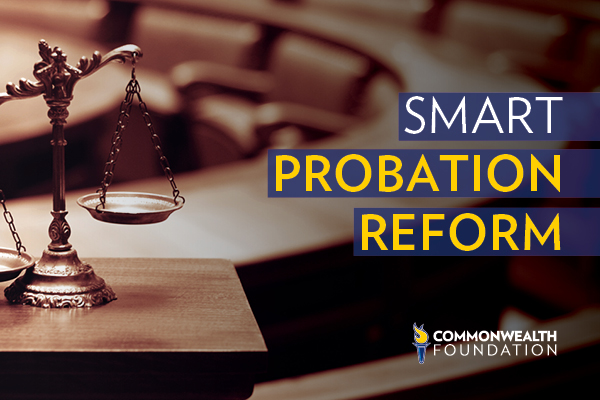Memo

Probation Reform Proposals Prioritize Public Safety and Cost Savings
Probation reform has gained momentum across the United States, and for good reason. Legislative changes in other states continue to pay dividends in decreased incarceration and rearrests—making Pennsylvania’s probation reform bills House Bill 1555 (Reps. Delozier and Harris) and Senate Bill 14 (Sens. Williams and Bartolotta) an important step toward smart justice.
Probation was meant to decrease the corrections population and costs because community supervision more effectively reduces repeat crime by individuals committing lower-level offenses. However, the probation system is cracked, limiting its effectiveness at deterring incarceration and crime.
The Case for Probation Reform
Jon Kelley is a pastor, father, and volunteer dedicated to improving his community. He’s also serving a post-incarceration probation sentence that could derail his rehabilitation, as he explains:
“The probation officers I’ve worked with since 2017 have petitioned three times for my early release from probation, but nobody’s willing to risk signing off—it’s a career-ending move if I were to re-offend.”
Kelley is one of thousands of Pennsylvanians facing what amounts to perpetual probation—even when they remain crime-free. The state probation population has steadily increased to 180,000 individuals (nearly 20% higher than the national average) with an unacceptably high recidivism rate; between 10% and 23% of prison admissions are due to probation violations—costing an additional $200 million annually.
Why does Pennsylvania have such probation shortcomings? Ineffective, unusually long probation sentences and strict non-criminal technical probation sanctions.
More specifically, Pa. is an anomaly in allowing probation terms to equal the statutory maximum for a person’s offense, meaning a probation term could last decades in contrast to the 31 states capping probation at five years or less.
Most individuals who reoffend will do so within the first two years of probation. Indeed, research shows that continuously supervising individuals with low risk of reoffending actually increases their likelihood of rearrests, while focusing resources on the higher-risk individuals early on decreases that likelihood.
These long sentences make technical violations more likely, circuitously extending probation beyond its effectiveness range. Violating technical standards—such as missing an appointment with a probation officer, changing residence without permission, or “consorting with disreputable persons”—trigger costly sanctions that can lead to prison. This difficulty can prevent activities that decrease crime, namely, getting a job and investing in the future. Thus, poorly-designed probation barriers feed the revolving door of incarceration and crime.
The Benefits of Proposed Probation Reforms
In the spirit of bipartisanship, HB 1555 and SB 14 have undergone a series of compromises that take Pennsylvania a step toward addressing the hurdles that limit probationers' success. The bills now include:
- Mandatory hearings to terminate probation terms at five years for a felony and three years for a misdemeanor. While there are still many exemptions and avenues to keep individuals on probation longer, this term limitation can equip judges to more quickly free individuals who have paid their debts. Shortening probation terms, which a judge can still do at any time, allows agencies and officers to focus on individuals when they are at greatest risk of offending.
- Technical violation changes, including reining in the court’s ability to prohibit probationers’ travel unless they are likely to flee or commit another crime. Further, the bill replaces a broad “vindication of the court” provision by which judges could send an individual to jail simply because they considered it reasonable or justified, with a more specific list of behaviors that will result in incarceration.
- While the specific impacts of these provisions are debatable, limits on incarceration for violations should be encouraged, as proven effective in Louisiana where lawmakers established a 90-day limit on incarceration for first-time violations. The state decreased new crime revocations by 22%, saving taxpayers $17.6 million in just eight years.
- Incentivizing and rewarding probation compliance, which proves highly effective at minimizing rearrests. Individuals can qualify for reduced sentences through “earned time” for educational credits and “good time” for staying sanction-free.
- Missouri policymakers instituted a similar approach, resulting in 36,000 probationers and parolees reducing their supervision terms by an average of 14 months. Consequently, the state’s supervised population fell by 18% with no adverse effects on recidivism rates. Likewise, Arizona offered earned time credits and performance funding for counties, reducing probation violations and saving $36 million from just 2008–10
- Takes a step toward protecting the poor from penalization by specifying that probation cannot be extended solely for a failure to pay a fine or court cost if they are unable to do so. A probationer, however, can be forced to remain on a less intensive “administrative probation” if restitution is not paid.
These reforms can help reduce caseloads, prevent reoffending, and produce savings. According to SB 14’s fiscal note, the anticipated inmate reduction will save the Department of Corrections $5.7 million annually. Additionally, counties will annually save $66,941 for every 10 defendants diverted from county jail.
Breaking the law does, and should, have consequences. But we need to ask, when does the punishment end and when does it impose more community harm than safety? These reforms provide a better path off probation away from crime—leading to personal success, taxpayer savings, and safer communities. It’s no wonder Pennsylvania voters want reform. Harper Polling (January 2020) found 67% of voters across the political spectrum support the probation reform bills, reflecting a September 2019 GCQ poll showing 75% support.
The history of these two bills shows a strong commitment to compromise and consideration of each stakeholder’s concern, from judges to probationers—culminating most recently in the Senate unanimously passing SB 14. Now is the time to join the states enjoying the success of reform and vote for probation reform in the House.